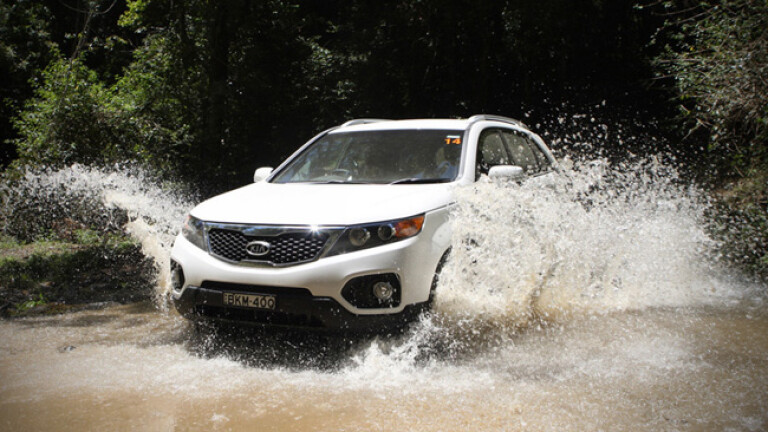
Kia’s Sorento has morphed from a cheap little 4X4 into a refined and big-value SUV.
If you haven’t driven a new vehicle from Korea in the past five years, then you should forget any preconceived ideas you may have, and get yourself to a dealer for a test drive. Cars and SUVs coming from Kia – and its close relation, Hyundai – are no longer the cheap and not-so-cheerful, oddly designed budget options they once were. Instead, they have evolved into refined and sophisticated vehicles well suited to the Australian buyer and the Australian driving environment.
Kia’s current-generation Sorento is a case in point. The first model won fans here as an affordable, mid-size 4X4 wagon with moderate off-road ability thanks to its traditional body-on-chassis design, low-range equipped transfer case and a willing turbo-diesel engine. A handy towing capacity made it popular with caravanners, too, but it didn’t have the refinement or performance to make it a true winner.
It’s a shame that Kia didn’t carry the traditional 4X4 design attributes over to the second-generation Sorento as it could have been a very impressive vehicle given the recent quality shown by the Koreans. The same could be said about Hyundai’s Terracan, which had a similar following, but was replaced by a softroader. But both Kia and Hyundai are after sales numbers, and softroaders are where they will find them. The second-generation Hyundai Santa Fe replaced the Terracan as the family AWD in its range, and the turbo-diesel variant surprised many with its family-friendliness and all-road usability, despite being a single-range softroader. The second-generation Sorento is based on the same platform and drivetrain as the Santa Fe, and has been further tweaked by Kia.
It may not have the off-road appeal of the old Sorento, but the new model is still an impressive vehicle. Very impressive, in fact. It brings a level of style, refinement and equipment never previously associated with Korean vehicles, but still at an affordable price.
Our test vehicle was the mid-spec Sorento SLi with the turbo-diesel engine and auto transmission. There’s a base-spec Si model and top-whack Platinum edition, while there’s also a single Si-spec-only four-cylinder petrol model available in front-wheel drive. All AWD Sorentos are powered by the 2.2-litre turbo-diesel, backed by either a six-speed manual or six-speed auto transmission. The Sorento SLi tested retails for a tempting $46,190.
Much of the Sorento’s new-found style comes thanks to Kia’s design chief, Peter Schreyer, who comes to the brand after a history at the Volkswagen Group, where he worked on VW, Audi and Lamborghini designs. Where some previous cars designed in Korea tended to look as though they were penned by a classroom of eight-year-olds, the new Sorento – and most of the current Kia range – have a much more sophisticated look, inside and out. While Kia has a design centre in Frankfurt, Germany, much of the styling for the Sorento was done in its California studio. According to Peter Schreyer, “the dynamic design of the new Kia Sorento adopts simple, linear lines to create a powerful, yet polished appearance. Both sporty and striking, new Sorento represents a new breed of SUV.”
The US-influence might explain the Sorento’s growth spurt, as it is longer and wider than the old model, but forgoing a separate chassis and dual-range transmission has left it lighter. The extra length allows Sorento to be a seven-seater with the rear pews folding flat into the floor of the plentiful cargo space. But, as you would expect of a wagon that is at the smaller end of the mid-size SUV class, the rear seats are only for kids.
After your initial visual impression of a vehicle, the next thing you are likely to notice is the driver’s seat. It might be just a personal preference, but I do believe it is a safer and more comfortable design when the back of the seat follows the contour of your back and neck right up to the back of your head. This makes driving more relaxing and safer as there is no room for your neck to snap back if the vehicle is rear-ended. The leather-clad front seats remind me of Volvo seats in this regard, and the Swedes are the kings of safety.
The entire interior has a quality feel about it. The most recent 2011 upgrade saw the inclusion of Bluetooth connectivity for phone and media streaming, and a rear-view camera, the screen for which is located in the rear-view mirror. Add power-adjusted front seats, dual-zone climate control with individual rear seat controls and a good sound system to the mix of usual features and the whole package continues to impress.
The diesel engine and auto transmission are neither astounding nor deficient. They are smooth, quiet and do the job asked of them very well. The torquey turbo-diesel and auto give plenty of pull for steep climbs or overtaking, and there is hill descent control to help on the way back down. The AWD system works on demand with the drive going to the front wheels most of the time, and all wheels when needed. It is a bit slow to react as it waits for front-wheel spin before doing its job. There is a centre diff lock button that helps to get out of sticky situations and ties the chassis down a bit if driven enthusiastically on gravel roads, but the Sorento is not a serious off-roader, nor is it a rally car.
What it is is a well-polished, nicely packaged and strong enough performing family SUV that’s worthy of consideration. Once you look at the features you get for the price and Kia’s five-year warranty, it could end up at the top of your list.



COMMENTS